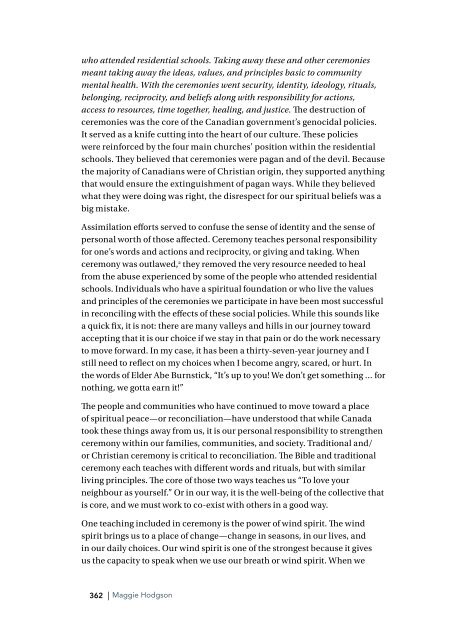Maggie Hodgson - Speaking My Truth
Maggie Hodgson - Speaking My Truth
Maggie Hodgson - Speaking My Truth
You also want an ePaper? Increase the reach of your titles
YUMPU automatically turns print PDFs into web optimized ePapers that Google loves.
who attended residential schools. Taking away these and other ceremonies<br />
meant taking away the ideas, values, and principles basic to community<br />
mental health. With the ceremonies went security, identity, ideology, rituals,<br />
belonging, reciprocity, and beliefs along with responsibility for actions,<br />
access to resources, time together, healing, and justice. The destruction of<br />
ceremonies was the core of the Canadian government’s genocidal policies.<br />
It served as a knife cutting into the heart of our culture. These policies<br />
were reinforced by the four main churches’ position within the residential<br />
schools. They believed that ceremonies were pagan and of the devil. Because<br />
the majority of Canadians were of Christian origin, they supported anything<br />
that would ensure the extinguishment of pagan ways. While they believed<br />
what they were doing was right, the disrespect for our spiritual beliefs was a<br />
big mistake.<br />
Assimilation efforts served to confuse the sense of identity and the sense of<br />
personal worth of those affected. Ceremony teaches personal responsibility<br />
for one’s words and actions and reciprocity, or giving and taking. When<br />
ceremony was outlawed, 2 they removed the very resource needed to heal<br />
from the abuse experienced by some of the people who attended residential<br />
schools. Individuals who have a spiritual foundation or who live the values<br />
and principles of the ceremonies we participate in have been most successful<br />
in reconciling with the effects of these social policies. While this sounds like<br />
a quick fix, it is not: there are many valleys and hills in our journey toward<br />
accepting that it is our choice if we stay in that pain or do the work necessary<br />
to move forward. In my case, it has been a thirty-seven-year journey and I<br />
still need to reflect on my choices when I become angry, scared, or hurt. In<br />
the words of Elder Abe Burnstick, “It’s up to you! We don’t get something … for<br />
nothing, we gotta earn it!”<br />
The people and communities who have continued to move toward a place<br />
of spiritual peace—or reconciliation—have understood that while Canada<br />
took these things away from us, it is our personal responsibility to strengthen<br />
ceremony within our families, communities, and society. Traditional and/<br />
or Christian ceremony is critical to reconciliation. The Bible and traditional<br />
ceremony each teaches with different words and rituals, but with similar<br />
living principles. The core of those two ways teaches us “To love your<br />
neighbour as yourself.” Or in our way, it is the well-being of the collective that<br />
is core, and we must work to co-exist with others in a good way.<br />
One teaching included in ceremony is the power of wind spirit. The wind<br />
spirit brings us to a place of change—change in seasons, in our lives, and<br />
in our daily choices. Our wind spirit is one of the strongest because it gives<br />
us the capacity to speak when we use our breath or wind spirit. When we<br />
362 | <strong>Maggie</strong> <strong>Hodgson</strong>

















